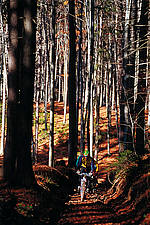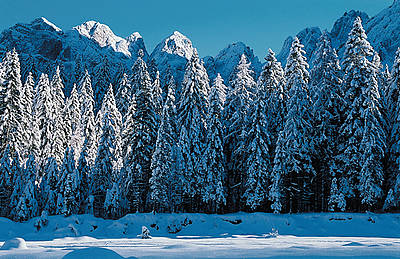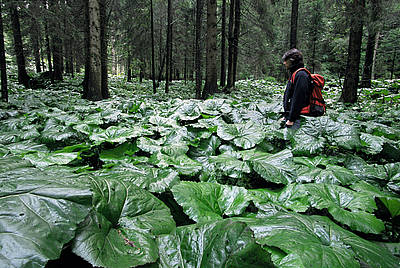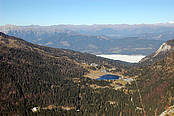The Woodlands
The area enclosed by Monte Cavallo and Monte Madrizze consists of mixed spruce and larch woodland with a number of wide clearings. The woodland encroached on the pastures with the decline of grazing, and varies in character from place to place: on the slopes of Cavallo, where the soil is poor and stony, larch and pine predominate, while in more fertile areas spruce prevails, mixed with larch and beech, and forming an impressive woodland stretch near Casera Winkel.
At higher elevations the woodland gives way to pastureland, which now shows mixed shrubbery, including willow, green alder, dwarf juniper, rhododendron, and various species of bilberry. Similar vegetation is found around the lake, mixed with typical wetland species such as ferns, sphagnum moss and bearded campanula. Between the Pramollo Pass and Sella Carnizza, the area that extends from the lake to the slopes of Monte Auernig is covered by dense growths of green alder, evidence of the abundant surface water. Elsewhere spruce and larch predominate, with pine and other shrubbery more common at lower levels.
Untended pastureland is found lower down the slopes at Casera Auernig. The area’s unique floral richness is represented by Wulfenia carinthiaca, known only here, in the adjacent Austrian Alps and in the Himalayas. It is the region’s most important and best known floral species, and is used as the symbol of the Carnic Alps. It was first discovered in 1779 by Baron Francesco Saverio de Wulfen, and inhabits a small stretch of land of approximately 10 sq km that straddles the border between Italy and Austria. The most intriguing aspect of this species relates to its origin, attributed to the Tertiary Period, and presumably arising from migration of an Asiatic stock. This species is found in the mountainous border between Albania and former Yugoslavia, while similar varieties are found in the Himalayas and in Asia Minor.
Wulfenia thrives best in relatively humid and open alpine sites in the transition zone between woodland and pasture. Because of its rarity and limited distribution, this species must be protected to ensure its survival. It has been added to the list of protected species under Regional Law 34/1981, and may not be picked or collected.










